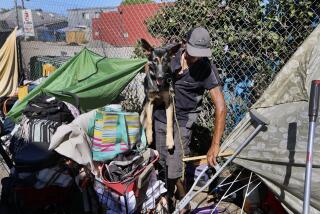City Bulldozes Homeless Camp
- Share via
A makeshift encampment a stone’s throw from Staples Center was cleared of more than 100 street people by police before a city skip loader flattened it Monday.
City officials said they were responding to complaints from local businesses, increasing crime and unsanitary conditions at the encampment, next door to a homeless shelter on Golden Avenue just west of the Harbor Freeway.
Los Angeles police had posted notices warning the homeless that their camp would be dismantled Monday and offering room in shelters. Only four of dozens displaced in the early morning operation took advantage of the offer, authorities said. Police said they were enforcing a recently enacted ordinance prohibiting sleeping on public sidewalks, a chronic problem downtown.
Early in the morning, homeless people, ranging from teenagers to septuagenarians, gathered up their blankets, tarps, cups and toothbrushes and stood along James M. Wood Boulevard as a skip loader, street cleaner and two large dump trucks moved into position.
Watching the scene unfold, Christine Garcia, 43, said she felt lonely and desperate after having been evicted from an area she described as a “safe haven.”
“I came here to live and felt like things were going to be all right,” said Garcia, who was forced out on the streets last summer when a friend died.
“I’m desperate right now, I’m scared, and this is all I have,” she said, gesturing toward two carts filled with her possessions.
Ted Hayes, an advocate for the homeless, tried at one point to block the path of one of the big machines before standing aside.
“It’s harassment, period,” said Hayes, wearing a black robe and carrying a U.S. flag. “The homeless situation here was contained, and now they want to make it worse. It’s been going on for decades.”
Rebecca Dryer, an advocate for the homeless who has been around the area the last four years, said many of those who congregated on the cul-de-sac were “shelter resistant” and not interested in the structure of a shelter.
“It’s because they can’t live their lives the way they need to and the way they should be allowed to,” said Dryer, accompanied by a German shepherd mix. “This is America.”
LAPD Capt. Charlie Beck, who has long dealt with the homeless problem as commanding officer of the Central Area and more recently the Rampart Area, said allowing encampments to mushroom hurts everyone.
“There are people here who don’t want any rules on their behavior,” Beck said. “What goes on here is not good. It’s not good for them and it’s not good for the community, including the businesses that operate here.
“Living on the street keeps people from seeking treatment for mental-health issues, substance abuse or other health problems.”
Despite the short protest, authorities reported no arrests or citations. The LAPD conducts such sweeps targeting larger encampments several times a year, Beck said. Smaller enforcement actions against people putting up makeshift shelters on the street during the day take place every day, he said.
Ben Wizner, a lawyer for the American Civil Liberties Union, which has filed a federal lawsuit against the LAPD over its enforcement of the city law outlawing sleeping on sidewalks, said the LAPD was simply shuffling bodies.
“All they are doing is moving people from one block to another. That’s not a solution,” Wizner said. “Anyone who works on any depth on this issue knows you don’t solve this problem with police. This problem has to be addressed at its roots. There’s been so much development and not enough attention paid to low-income affordable housing, and that’s the only way to sustain a long-term solution.”
LAPD Chief William J. Bratton defended the actions.
“We will continue to do this,” Bratton said Monday. “If you don’t deal with it, it gets larger and larger.”
Bratton said such encampments lead to prostitution, street robberies and other crimes.
Mitchell Netburn, director of the Los Angeles Homeless Services Authority, a city-county agency, said that in recent months the homeless population in the cul-de-sac adjacent to Hayes’ Dome Village had grown from about 15 people to more than 100, after Hayes invited them to use kitchen and bathroom facilities at his shelter.
Netburn said four of those who moved out of the cul-de-sac were placed in shelters, adding that there was plenty of room in city facilities. Beck agreed, saying that everyone on Golden Avenue who needed a bed could get one, and most refused the offer.
But Hayes said the city’s homeless policy was created by those trying to preserve “the status quo.”
He said he had invited those who were homeless and squatting nearby to come to the cul-de-sac where he could “manage the situation.”
One of them was Patti, 73, a former dancer who learned there was a space in Hayes’ shelter for her. She sat eating a cracker and butter sandwich with her dog as a bulldozer collapsed the makeshift shelters. “Most of us aren’t criminals,” she said. “Now I have a place to take my things.”
More to Read
Sign up for Essential California
The most important California stories and recommendations in your inbox every morning.
You may occasionally receive promotional content from the Los Angeles Times.













